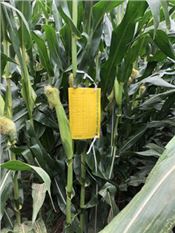|
Corn Rootworm Monitoring Program Guides Growers In Making Informed Management Decisions

DOWNERS GROVE, ILL.
As corn rootworm (CRW) pressure spikes in the Midwest, Syngenta is helping growers minimize the long-term impact through a robust monitoring program to guide long-term management strategies.
So far this season, Syngenta monitoring has seen a rise in CRW threats, likely the result of a turbulent 2019 where less-than-ideal weather resulted in delayed planting, combined with dry conditions this spring.
"We've seen heavier than normal CRW pressure throughout the U.S., with the heaviest pressure observed in the key rootworm geographies of northern Illinois, Iowa, Wisconsin, southern Minnesota, Nebraska and Colorado," said Andy Heggenstaller, head of agronomy for Syngenta Seeds. "Although these are the highest populations we've recorded in the past five years, the good news is that our monitoring program is also finding that growers who are incorporating multiple management practices are getting ahead of the challenge."
Long-term CRW management requires a multi-year, whole-farm approach that includes the integration of multiple control measures, not a singular technology. For growers looking to effectively control CRW, Syngenta recommends having a plan in place for each field that includes multiple control strategies including crop rotation, corn rootworm-traited corn hybrids, soil-applied insecticides and adult beetle management.
The monitoring program, announced this spring, was designed to provide growers with the support they need to monitor adult CRW in their fields and supply knowledge to help make better, more informed management decisions. One tactic that has benefited growers is the use of yellow sticky traps, an easy and reliable tool for estimating CRW populations in corn fields.
"Every farm – and in many cases, every field – is unique, and effective CRW management requires year-by-year, field-by-field evaluation," said Heggenstaller. "Using yellow sticky traps, we are able to track the current year's beetle numbers and gauge the following year's larval threat. This information then helps us develop a long-term CRW management plan tailored to the specific needs of each field."
Because CRW has historically demonstrated the ability to overcome some management practices and control technologies, it's important to show CRW something different. Growers looking for a new trait rotational option for a healthier corn crop should consider planting Agrisure Duracade® trait stacks.
"Agrisure Duracade trait stacks feature a unique mode of action that demonstrates strong performance against CRW," said Tim O'Brien, PhD, Agrisure® traits manager for Syngenta. "The industry's most innovative solution for proactively protecting yield potential is the Agrisure Duracade 5222 E-Z Refuge® trait stack. Its novel, alternate modes of action help preserve trait durability and delay insect adaptation for long-term field health."
"When used in rotation with other industry trait technologies like Agrisure 3122 E-Z Refuge, Agrisure Duracade trait stacks provide a new trait rotation option for CRW management," he added.
The Agrisure traits portfolio is a direct result of a Syngenta commitment to address the increasing challenges for farmers. Syngenta continues to develop and invest in technologies that bring about positive lasting change for more sustainable agriculture.
Growers interested in utilizing the CRW monitoring program to make management decisions for next year should contact their local, independent Golden Harvest® Seed Advisor or local NK® retailer.
For more information on Agrisure Duracade trait stacks and to find additional resources about corn rootworm management, including a step-by-step Take Control of Corn Rootworm Management Brochure, visit www.agrisureduracade.com . Join the conversation online – connect with Syngenta at Syngenta-us.com/social . ∆
|
|